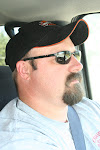 (Mom's hibiscus is GORGEOUS this year!)
(Mom's hibiscus is GORGEOUS this year!)Discogenic
Low back pain - a common condition, can be caused by lumbar sprain, spinal stenosis, disc herniation, and different degenerative spinal disorders. The topic of today's discussion is discogenic low back pain; a degenerative condition. The term discogenic pain means one or more intervertebral discs are the pain source.
Symptoms of Discogenic Low Back Pain
As we age, our bodies undergo many changes. For example, our hair may begin to turn gray or thin. Similar gradual changes affect the spine's structures, notably the intervertebral discs. Early disc degeneration may not cause severe pain or other symptoms, but when the degeneration becomes advanced low back pain may occur.
Typically, discogenic pain is associated with activities that increase the pressure within the intervertebral disc (called intradiscal pressure). Sitting, bending forward, coughing and sneezing can increase low back discogenic pain. Leg pain caused by pinching of the nerves in the low back (called radiculopathy) may also accompany low back discogenic pain; especially while sitting, standing or walking. Discogenic low back pain is usually a chronic disorder.
How Discs Cause Pain
Just like other parts of the body, each intervertebral disc has a nerve supply. Discs are comprised of two parts; the annulus fibrosus (outer ring-like structure) and nucleus pulposus (gel-like interior). The nucleus pulposus is void of nerves. However, the outer third of the annulus fibrosus contains nerve fibers.
One type of discogenic disorder is called an Internal Disc Disruption (IDD). An IDD occurs when the disc tears or cracks (fissure) allowing the nucleus pulposus to meet the annulus fibrosus. When this happens, a chemical called a protecogylcan may be released from the nucleus pulposus. Protecoglycans may irritate the annular nerves causing an inflammatory response and pain. For unknown reasons, some people have annular tears and yet are symptom free!
Diagnosing Low Back Discogenic Pain
Degenerative disc changes can best be seen on MRI.
If one or more spinal discs are suspected as the pain source, the doctor may order a provocative discogram or discography. During this sterile procedure, the suspect discs are injected with a contrast dye to make each disc visible under fluoroscopy. Provocative discography helps the doctor to see the shape and size of the intervertebral disc. The injection of the contrast dye alters the pressure within the disc and may 'provoke' or reproduce the patient's pain pattern; thereby helping to isolate a particular disc as a pain generator.
Non-Surgical Treatments
There are many different types of treatment to help relieve low back and leg pain. Often, treatments are combined for better symptom control or relief.
Medication: anti-inflammatory drugs, anti-depressants, opioids.
Physical Therapy: passive therapies such as ultrasound, transcutaneous nerve stimulation (TENS), and massage may be combined with a disciplined program of stretching and strengthening exercise. Core strengthening (strengthening of the abdominal and low back muscles) is often helpful in relieving pain from degenerative disc disease. When the muscles around the disc become stronger, they may shield the disc from loads and may reduce pain.
Spinal Injections: local anesthetics combined with long-acting corticosteroid injections. This medication combination may be injected into the facet joints or around the nerves of the back to help reduce back pain and radicular leg pain.
Bracing: braces (orthoses) help support the back and limit movement that may provoke painful episodes. Rarely is bracing a long-term treatment for back pain. Long-term bracing may lead to weakened back and abdominal muscles which may provoke muscle spasm.
Alternative Therapies: acupuncture, hydrotherapy and magnet therapy.
Lifestyle Modification: dieting to reach a more 'back friendly' body weight, smoking cessation, and physical activity help maintain a healthy spine.
Minimally Invasive Procedures
Many different spine surgical procedures can be performed using minimally invasive techniques. For example, spine surgeons use such techniques to treat herniated discs, correct scoliosis, and perform spinal fusion. The benefits to the patient are enormous and include smaller incisions, shorter time hospitalized, less post-operative pain, and a speedier recovery. Spinal fusions may alleviate disc related back pain by replacing the disc with bone and cages. Recently, artificial lumbar discs have become another option to replace degenerated discs.
Sources
Mummaneni PV, Haid RW, Rodts GE. Lumbar Interbody Fusion: State of the Art Technical Advances. Journal of Neurosurgery: Spine. 2004; 1:24-30.
Mummaneni PV, Rodts GE. The Mini-Open Transforaminal Lumbar Interbody Fusion. Neurosurgery. 2005; 57(4 Suppl): 256-261.
Wang J, Mummaneni PV, Haid RW. Current Treatment Strategies for the Painful Lumbar Motion Segment: Posterolateral Fusion Versus Interbody Fusion. Spine. 2005; 30(16 Suppl): S33-43.
Bogduk N, Twomey LT. Clinical Anatomy of the Lumbar Spine, 2nd Ed. Churchill Livingstone, London. 1991.
Waldman SD, Winnie AP. Interventional Pain Management. W.B. Saunders Company, Philadelphia, PA. 1996.
Low back pain - a common condition, can be caused by lumbar sprain, spinal stenosis, disc herniation, and different degenerative spinal disorders. The topic of today's discussion is discogenic low back pain; a degenerative condition. The term discogenic pain means one or more intervertebral discs are the pain source.
Symptoms of Discogenic Low Back Pain
As we age, our bodies undergo many changes. For example, our hair may begin to turn gray or thin. Similar gradual changes affect the spine's structures, notably the intervertebral discs. Early disc degeneration may not cause severe pain or other symptoms, but when the degeneration becomes advanced low back pain may occur.
Typically, discogenic pain is associated with activities that increase the pressure within the intervertebral disc (called intradiscal pressure). Sitting, bending forward, coughing and sneezing can increase low back discogenic pain. Leg pain caused by pinching of the nerves in the low back (called radiculopathy) may also accompany low back discogenic pain; especially while sitting, standing or walking. Discogenic low back pain is usually a chronic disorder.
How Discs Cause Pain
Just like other parts of the body, each intervertebral disc has a nerve supply. Discs are comprised of two parts; the annulus fibrosus (outer ring-like structure) and nucleus pulposus (gel-like interior). The nucleus pulposus is void of nerves. However, the outer third of the annulus fibrosus contains nerve fibers.
One type of discogenic disorder is called an Internal Disc Disruption (IDD). An IDD occurs when the disc tears or cracks (fissure) allowing the nucleus pulposus to meet the annulus fibrosus. When this happens, a chemical called a protecogylcan may be released from the nucleus pulposus. Protecoglycans may irritate the annular nerves causing an inflammatory response and pain. For unknown reasons, some people have annular tears and yet are symptom free!
Diagnosing Low Back Discogenic Pain
Degenerative disc changes can best be seen on MRI.
If one or more spinal discs are suspected as the pain source, the doctor may order a provocative discogram or discography. During this sterile procedure, the suspect discs are injected with a contrast dye to make each disc visible under fluoroscopy. Provocative discography helps the doctor to see the shape and size of the intervertebral disc. The injection of the contrast dye alters the pressure within the disc and may 'provoke' or reproduce the patient's pain pattern; thereby helping to isolate a particular disc as a pain generator.
Non-Surgical Treatments
There are many different types of treatment to help relieve low back and leg pain. Often, treatments are combined for better symptom control or relief.
Medication: anti-inflammatory drugs, anti-depressants, opioids.
Physical Therapy: passive therapies such as ultrasound, transcutaneous nerve stimulation (TENS), and massage may be combined with a disciplined program of stretching and strengthening exercise. Core strengthening (strengthening of the abdominal and low back muscles) is often helpful in relieving pain from degenerative disc disease. When the muscles around the disc become stronger, they may shield the disc from loads and may reduce pain.
Spinal Injections: local anesthetics combined with long-acting corticosteroid injections. This medication combination may be injected into the facet joints or around the nerves of the back to help reduce back pain and radicular leg pain.
Bracing: braces (orthoses) help support the back and limit movement that may provoke painful episodes. Rarely is bracing a long-term treatment for back pain. Long-term bracing may lead to weakened back and abdominal muscles which may provoke muscle spasm.
Alternative Therapies: acupuncture, hydrotherapy and magnet therapy.
Lifestyle Modification: dieting to reach a more 'back friendly' body weight, smoking cessation, and physical activity help maintain a healthy spine.
Minimally Invasive Procedures
Many different spine surgical procedures can be performed using minimally invasive techniques. For example, spine surgeons use such techniques to treat herniated discs, correct scoliosis, and perform spinal fusion. The benefits to the patient are enormous and include smaller incisions, shorter time hospitalized, less post-operative pain, and a speedier recovery. Spinal fusions may alleviate disc related back pain by replacing the disc with bone and cages. Recently, artificial lumbar discs have become another option to replace degenerated discs.
Sources
Mummaneni PV, Haid RW, Rodts GE. Lumbar Interbody Fusion: State of the Art Technical Advances. Journal of Neurosurgery: Spine. 2004; 1:24-30.
Mummaneni PV, Rodts GE. The Mini-Open Transforaminal Lumbar Interbody Fusion. Neurosurgery. 2005; 57(4 Suppl): 256-261.
Wang J, Mummaneni PV, Haid RW. Current Treatment Strategies for the Painful Lumbar Motion Segment: Posterolateral Fusion Versus Interbody Fusion. Spine. 2005; 30(16 Suppl): S33-43.
Bogduk N, Twomey LT. Clinical Anatomy of the Lumbar Spine, 2nd Ed. Churchill Livingstone, London. 1991.
Waldman SD, Winnie AP. Interventional Pain Management. W.B. Saunders Company, Philadelphia, PA. 1996.

























I was surprised to read this and find that chiropractic care was not listed as a way to help with pain. I honestly think that this Disogenic is what I may have...(only a guess) but with chiropractic care over the past I have felt great once again since November. Now I have to keep my fingers crossed that I stay feeling good. Think of you often since I know how bad back pain can be.
ReplyDelete